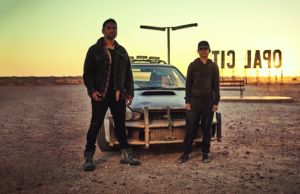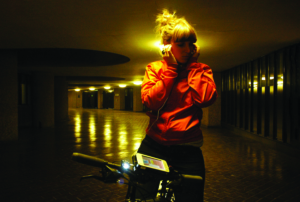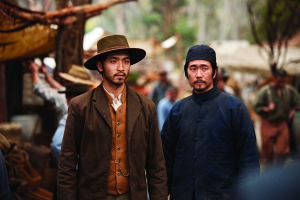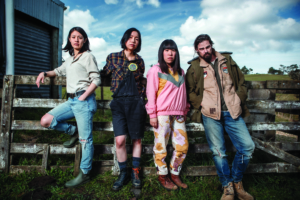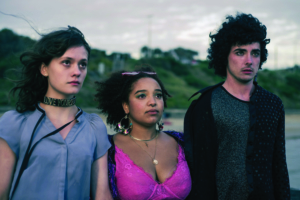In The Five Obstructions (co-directed by Lars von Trier, 2003), Danish filmmaker Jørgen Leth is asked to remake his cult short The Perfect Human (1968) five times over, under increasingly severe constraints. Orchestrated by the Machiavellian von Trier, the film plays out in a cat-and-mouse dynamic. For the first reimagined version, Leth must film with no set, with each shot lasting no longer than twelve frames; he travels to Cuba to complete the task and, much to von Trier’s bemusement, succeeds. In the second iteration, Leth must remake the film in his idea of the worst place on Earth, Mumbai’s red-light district. Each time, he triumphs in creating an inventive interpretation of the original – forced (or enabled) by von Trier’s attempts to get the better of him.
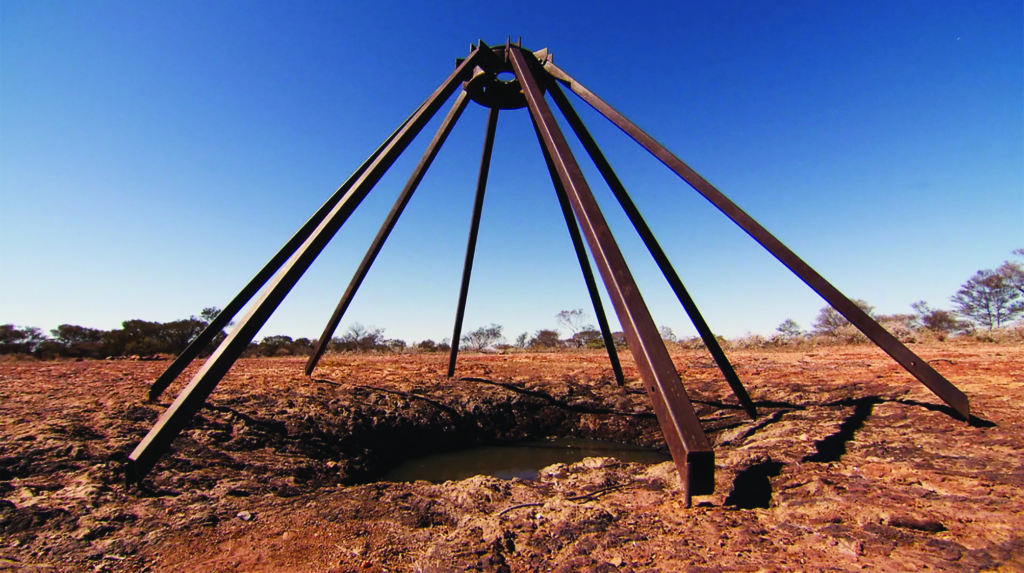
The Five Obstructions is a notable example of the creative potential of limitations and conceptual rules. However, looking farther afield, regulations and constraints are often an integral component of film industries, emerging from religious, political, economic or other structures. Iran’s film industry, for example, has used the rules imposed after the revolution in 1979 to transform itself into one of the world’s most highly regarded national cinemas.[1]See Kourosh Ziabari, ‘Iranian Cinema Thrives on Censorship 40 Years On’, Asia Times, 4 March 2019, <https://asiatimes.com/2019/03/iranian-cinema-thrives-on-censorship-40-years-on/>, accessed 11 August 2020. As new rules are imposed, filmmakers find ways to subvert the constraints and succeed via new cinematic forms. In Jafar Panahi’s This Is Not a Film (2011), for example,the filmmaker navigates his house arrest and ban on making films to produce a part diary, part hybrid-documentary essay that was mythically smuggled out of Tehran in a cake to premiere at the Cannes Film Festival.[2]See Karina Longworth, ‘This Is Not a Film:The Filmmaker Who Isn’t’, The Village Voice, 29 February 2012, <https://www.villagevoice.com/2012/02/29/this-is-not-a-film-the-filmmaker-who-isnt/>, accessed 10 August 2020.
Since March, when COVID-19 was officially declared a pandemic, film productions around the world have been suspended, and film festivals have either gone virtual or been cancelled altogether. In various stages of lockdown, filmmakers have continued to make small-scale films from their homes or safe environments nearby. And with this, local and international quarantine and isolation film festivals have popped up through various streaming platforms to showcase these rapidly produced shorts. As their contribution to this new landscape, online video-art / experimental-film platform Prototype commissioned a series of rapid-response works ‘inspired’ by lockdown, both formally and conceptually. Initiated by the platform’s founder and curator, Lauren Carroll Harris, the project comprised eight short films that either were made specifically for the platform or had been forced to find an alternative outlet due to the cancellation of various exhibitions and public screenings.
I discuss three of these shorts – Robert Nugent’s Picnic Places,[3]Picnic Places is available to watch at <https://vimeo.com/407835368/9c7b6f9117>, accessed 10 August 2020. Leyla Stevens’ Scenes for Solace[4]Scenes for Solace is available to watch at <https://vimeo.com/411966517/7860998f56>, accessed 10 August 2020. and Sarah Hadley’s Noli Me Tangere (Touch Me Not)[5]Noli Me Tangere (Touch Me Not) is available to watch at<https://vimeo.com/422703873>, accessed 10 August 2020. – in this article, for which I spoke to the three directors as well as Carroll Harris. By adopting the generative practices of appropriating and recycling materials, these filmmakers demonstrate the creative possibilities of constraints. Further, these works reflect the material conditions of their production while also providing parallel narratives that contextualise and mirror the communal lived experience of the pandemic.
Sitting in the space between experimental film and video art, Prototype is an online portal that distributes videos to subscribers’ email inboxes via what Carroll Harris calls ‘care packages’. Launched in 2019, Prototype rethinks how video art can be exhibited in a way that allows for broader access and exposure. Eschewing the gallery space, the direct delivery of these films enables them to reach beyond the metropolitan centres of Sydney and Melbourne, where most Australian cultural venues are concentrated. For Carroll Harris, who was about to relocate to France when the pandemic hit, COVID-19 instead presented an opportunity to launch a timely response by commissioning filmmakers and artists for its second series.[6]For a discussion of the platform’s first series, see Stuart Richards, ‘Prototype Review: Experimental Australian Films as Poetic Diary Entries’, The Conversation, 1 October 2019, <https://theconversation.com/prototype-review-experimental-australian-films-as-poetic-diary-entries-123921>, accessed 11 August 2020. In this way, the prescient Prototype was well placed to respond to the pandemic and also relatively unaffected by the mass shutdown of cultural institutions.
Launching the series was Canberra-based experimental ethnographic filmmaker Nugent’s thoughtfully strange Picnic Places. The film is loosely based on Arkady and Boris Strugatsky’s 1972 Russian science fiction novel Roadside Picnic, famously the inspiration for the classic Andrei Tarkovsky film Stalker (1979),in which the eponymous character leads a small group into the forbidden ‘Zone’ in search of fulfilment of desire. Told through Polish voiceover, Picnic Places depicts an archaeologist examining relics and ephemera found alongside roads in central Australia, trying to make sense of the place from what she encounters. In a double act of rummaging and reflection, the six-and-a-half-minute shortboth methodologically and conceptually mines what has been overlooked.
Commissioned in March as we all headed into lockdown, Nugent faced the challenge of making a short film without the liberty of shooting new material, prompting him to instead explore the content on his hard drives. This allowed the director to repurpose footage from his 2016 film Night Parrot Stories, a road trip of sorts that traces sightings of the elusive bird.[7]See Lauren Carroll Harris, ‘Darkness Calls: Robert Nugent’s Night Parrot Stories and Contemporary Documentary Making’, Metro, no. 194, 2017, pp. 90–3. While making this feature film, Nugent felt that there was another story hidden in the footage – not about the parrot, but about the strange structures and missing plaques on the roadside stops that interspersed his filmmaking journey through central Australia.
Eschewing the gallery space, the direct delivery of these films enables them to reach beyond the metropolitan centres of Sydney and Melbourne, where most Australian cultural venues are located.
Following Picnic Places’ brief introduction, remnants of colonial intrusion appear: a stark white picnic table and chairs cemented onto the landscape; an oversized iron frame that resembles a tent; an open hut with a corrugated iron roof. Framed as static shots and contrasted against the punchy desert light, these appear even odder than they would if we were to encounter them in real life. In the second chapter of the film, a collection of abandoned domestic objects appears on the red dirt. The strangeness of this tableau prompts the audience to consider questions of belonging and place. Intercut with these scenes are shrubs, reptiles and birds. The archaeologist also contemplates these objects, attempting to make sense of this seemingly alien landscape. She then encounters the missing plaques, and the mystery deepens.
In watching Picnic Places, there is a melancholic nostalgia for the open spaces. Yet, at the same time, the stark compositions, with the foreign language, makes strange the landscape of Australia. Viewing this film at this time, it’s easy to draw parallels and imagine future beings (or visitors from another planet) happening upon the relics of our time and trying to make sense of what kind of civilisation existed. In considering these ghostly images that speak so vividly of loss, Nugent draws attention to something much more rooted in the landscape and the languages that were once so prevalent here.
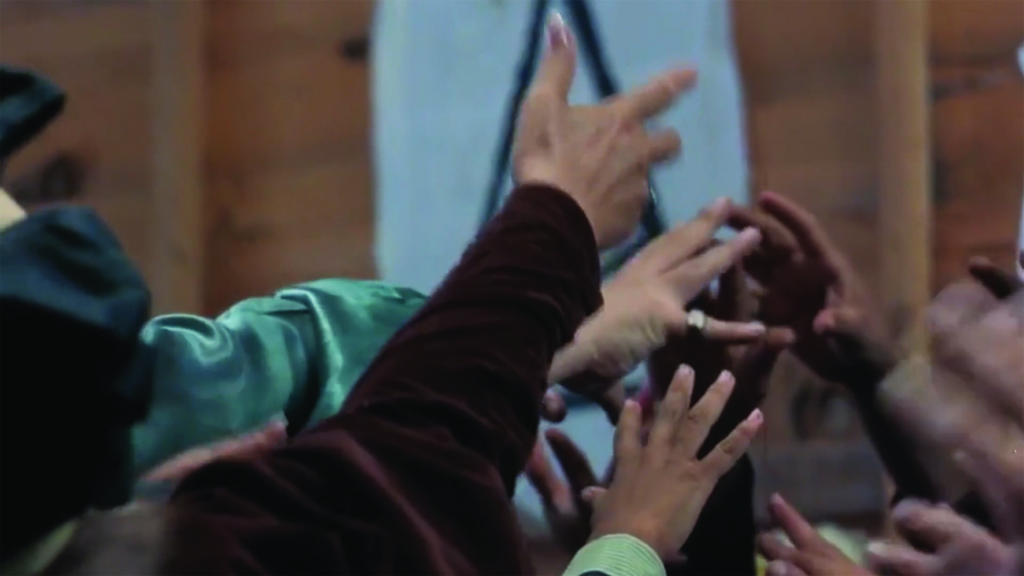
Sydney-based video artist Stevens also found herself ‘rummaging through the rubble’[8]A phrase mentioned by Carroll Harris when I interviewed her for this piece. of unfinished art projects for her poetic piece Scenes for Solace, discovering that the parameters of time given to create the project provided a welcome constraint. In our conversation, Stevens talked about the unpaid and often invisible labour of the artists whose work is seen in the short, and told me that her own artist fee was a boundary for the time she spent on the project.
Filmed in Indonesia, the first section, ‘Passage’, contains a collection of scenes loosely depicting spaces traversed: a boat on the water; a man with his back to us holding paddles and signalling to something in the sky; men at work gazing into the distance through binoculars; scenes from what I later learned was pigeon racing. In Part II, titled ‘Timekeeper’, a metronome or timekeeping device provides the soundtrack to a sequence of tasks being performed: a man cuts a key by hand, then a shot of two women sifting a black grain-like substance is reversed. Time is moving slowly forwards and backwards. And then some filmed footage, which Stevens tells me is from family archives: a man playing a traditional instrument in verdant surroundings; a Balinese dancing lesson; rice fields and a waterfall. In Part III, ‘Solace’, an image of a Graeco-Roman statue is inserted on top of another image of foliage. Then we are inside a building under reconstruction. A column lies on the ground, and bamboo scaffolding tells us we are not in Australia. The soundscape is tropical, speaking of wind and birds and chimes. A child’s torso is overlaid on a body of water.
Scenes for Solace’s chapterisation of moments recalls the stages of lockdown or phases of the pandemic, seeking to create order among fragments that may not otherwise necessarily form a coherent narrative.
As the title suggests, these form a collection of scenes, loosely arranged like a list – not, as Chris Marker might suggest, of ‘things that quicken the heart’,[9]A refrain from Marker’s Sans Soleil (1983), referencing Sei Shōnagon’s The Pillow Book. but instead of things that slow the mind. For Stevens, these images provide a kind of antidote for the digital fatigue exacerbated by current COVID times. Like Nugent’s film, Scenes for Solace’s chapterisation of moments recalls the stages of lockdown or phases of the pandemic, seeking to create order among fragments that may not otherwise necessarily form a coherent narrative. As I watch these collected scenes, not knowing exactly how to read them, I become attuned to the passing flow of events and responses that has become a solace for dealing with the unpredictability of the moment.
For theatre director and filmmaker Hadley, who also works as a camera assistant in the film and television industry, lockdown meant no more paid work. Acutely aware of the physical impact of social distancing, both on set and more broadly in everyday interactions, she started to consider how touch had become the new taboo. For Hadley, images of bodily contact now evoked an embodied response. With time on her hands, and an inability to shoot new projects, she revisited her vast film collection for the seventh instalment in the Prototype care package, Noli Me Tangere (Touch Me Not). The excerpts she uses range from Alain Resnais’ mysterious meditation on memory Last Year in Marienbad (1961) to Ridley Scott’s space-horror classic Alien (1979). Attuned to the rapid changes occurring around her, Hadley has meticulously selected moments that align with certain themes: order, touch and chaos. Each of these structures serves as a brief movement in this four-minute film.
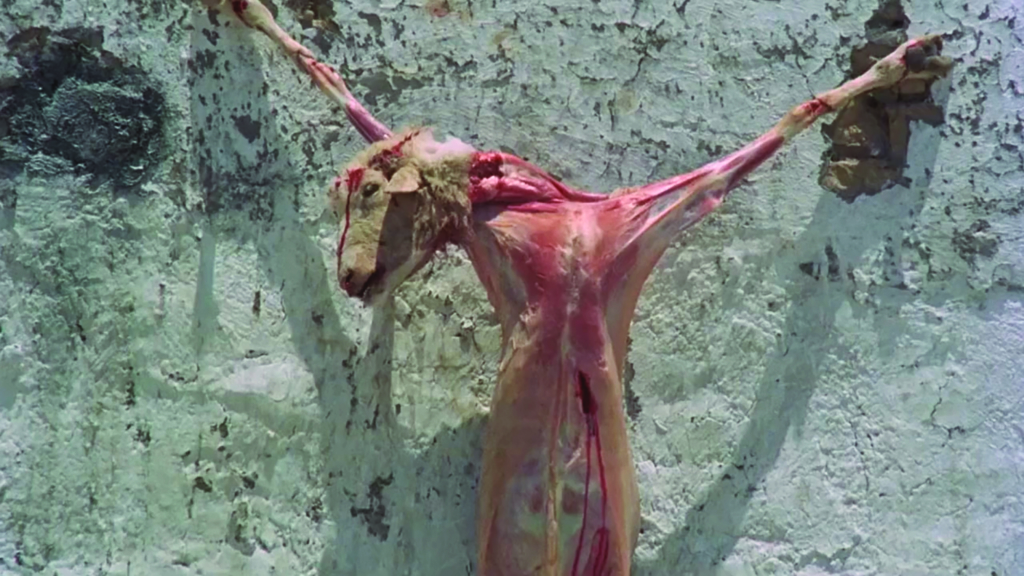
The film’s pre-title sequence features close-ups of a painting depicting the biblical scene in which Jesus utters to Mary Magdalene, ‘Touch me not.’[10]John 20:17 (King James Version), available at Bible Hub, <https://biblehub.com/john/20-17.htm>, accessed 10 August 2020. Two hands are at a distance. This image of ‘not-touching’ is followed by views of the sky, wheatfields and a river, along which the camera glides. The music, mirrored by what we know as we live this parallel moment, foreshadows a rupture. Bodies move through spaces in anticipation. The next sequence is a montage of hand scenes from various movies that I attempt to identify. Each of these conjures a moment or image in the recent pandemic-saturated media. Hands are in gloves, and then without gloves. They touch a wall, then objects, and now the air. The touching soon becomes intimate, with human-on-human contact: first tentative, and suddenly desperate. We know this won’t end well. Fingernails peel off, and hands grope at an unknown body. The images become increasingly visceral, grotesque and menacing. The third act brings us close to home, with chaotic scenes of supermarket panic-buying and trolleys full of life’s necessities, though toilet paper is not one of them. Images of fleeing crowds, a crucified skinned goat, a bloodied body in the water and then death exaggerate the chaos. Hadley’s editing draws attention to how cinema represents disasters, as well as underscoring how the context of the viewing situation changes everything.
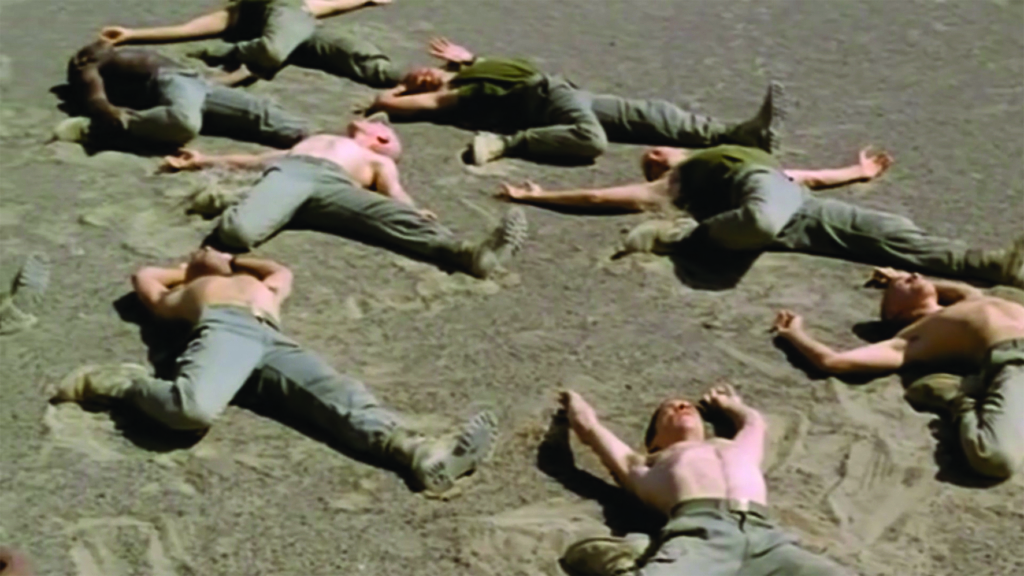
By framing these weekly missives as care packages, Prototype reconfigures and elevates the role of art and film in making sense of the world around us. This intervention feels especially important in this unique moment, in which many of us are prone to descending into doomsurfing or doomscrolling.[11]See Angela Watercutter, ‘Doomscrolling Is Slowly Eroding Your Mental Health’, Wired, 25 June 2020, <https://www.wired.com/story/stop-doomscrolling/>, accessed 12 July 2020. Whether through direct reference to the dangers of touch evident in Hadley’s work, revisiting the relics in Nugent’s, or the respite provided by Stevens’, each of these films is a palimpsest of the current moment. The films act as antidotes to attempts to comprehend this point in time rationally. Shifting away from the requirements of bricks-and-mortar sites to exhibit work has also been prescient in facilitating distribution that primarily sits outside the traditional needs of gallery spaces and the commodification of video art as an artefact. Prototype presents a sustainable model that, along with the inventive approaches employed by the filmmakers, enables production to weather possible future calamities.
https://youaretheprototype.art/
Endnotes
| 1 | See Kourosh Ziabari, ‘Iranian Cinema Thrives on Censorship 40 Years On’, Asia Times, 4 March 2019, <https://asiatimes.com/2019/03/iranian-cinema-thrives-on-censorship-40-years-on/>, accessed 11 August 2020. |
|---|---|
| 2 | See Karina Longworth, ‘This Is Not a Film:The Filmmaker Who Isn’t’, The Village Voice, 29 February 2012, <https://www.villagevoice.com/2012/02/29/this-is-not-a-film-the-filmmaker-who-isnt/>, accessed 10 August 2020. |
| 3 | Picnic Places is available to watch at <https://vimeo.com/407835368/9c7b6f9117>, accessed 10 August 2020. |
| 4 | Scenes for Solace is available to watch at <https://vimeo.com/411966517/7860998f56>, accessed 10 August 2020. |
| 5 | Noli Me Tangere (Touch Me Not) is available to watch at<https://vimeo.com/422703873>, accessed 10 August 2020. |
| 6 | For a discussion of the platform’s first series, see Stuart Richards, ‘Prototype Review: Experimental Australian Films as Poetic Diary Entries’, The Conversation, 1 October 2019, <https://theconversation.com/prototype-review-experimental-australian-films-as-poetic-diary-entries-123921>, accessed 11 August 2020. |
| 7 | See Lauren Carroll Harris, ‘Darkness Calls: Robert Nugent’s Night Parrot Stories and Contemporary Documentary Making’, Metro, no. 194, 2017, pp. 90–3. |
| 8 | A phrase mentioned by Carroll Harris when I interviewed her for this piece. |
| 9 | A refrain from Marker’s Sans Soleil (1983), referencing Sei Shōnagon’s The Pillow Book. |
| 10 | John 20:17 (King James Version), available at Bible Hub, <https://biblehub.com/john/20-17.htm>, accessed 10 August 2020. |
| 11 | See Angela Watercutter, ‘Doomscrolling Is Slowly Eroding Your Mental Health’, Wired, 25 June 2020, <https://www.wired.com/story/stop-doomscrolling/>, accessed 12 July 2020. |

